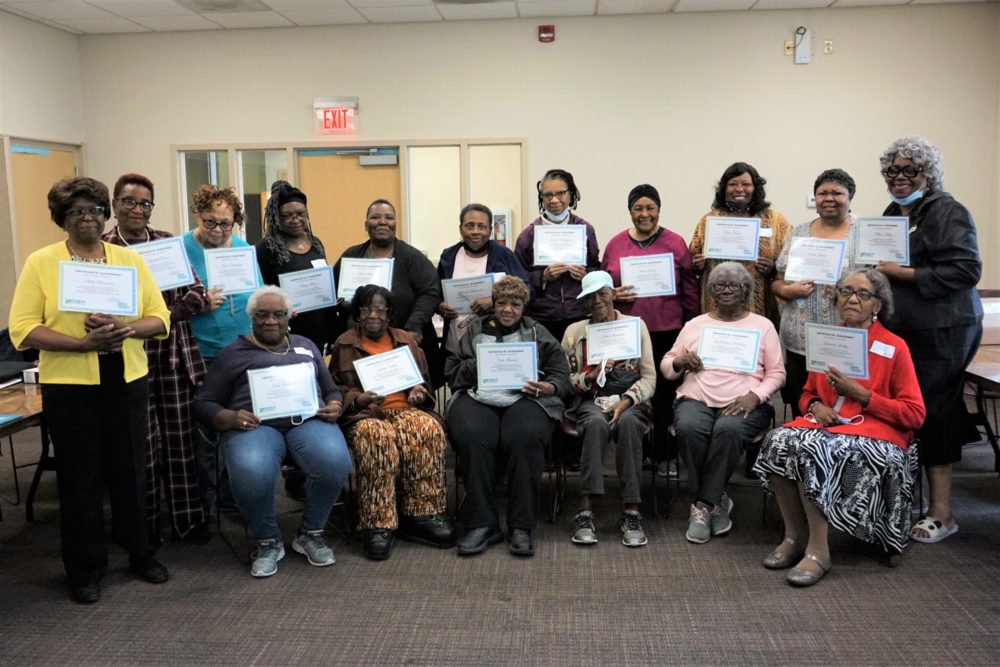
NEWS RELEASE
DATE: April 21, 2021
BAMBERG, SC—Senior citizens aged 60 years and up from Bamberg County recently completed a three-session digital inclusion learning program conducted by Palmetto Care Connections (PCC), a state-wide, non-profit telehealth organization.
The program was part of a $35,000 grant program funded by Spectrum to help seniors who live in rural communities with digital training and a chromebook at no cost as well as assistance with affordable internet service.
“We applaud Palmetto Care Connections for their broadband education initiatives and for helping us support efforts that promote digital literacy in rural South Carolina counties,” said Rahman Khan, Vice President of Community Impact for Charter Communications, Inc., which operates the Spectrum brand of broadband connectivity products. “Through this partnership with Palmetto Care Connections, the Spectrum Digital Education program is able to bring essential resources to those in need, and we look forward to continuing to work with them on this transformative project.”
“Palmetto Care Connections was honored to receive this Spectrum Digital Education Grant to help close the digital divide for senior citizens, especially during times like these, as we work to reduce social isolation and when the need for virtual access to health care providers is so great,” said Kathy Schwarting, Palmetto Care Connections Chief Executive Officer. “With Spectrum’s assistance, PCC is providing hands-on digital training for 100 seniors who live in Bamberg, Oconee, Pickens, Marion and Dillon counties.”
Over the course of three, two-hour classes, participants learn how to send and receive photos and emails, safely search the internet for health information, connect with family and friends using a virtual face-to-face app, play mind-expanding games and connect with their doctor for virtual telehealth appointments.
“I think this training is wonderful for someone my age. I will definitely use telehealth. It will save gas, time and I can speak from the house – that’s exciting! It will be a joy the first time I see my doctor with telehealth,” said participant Marie Stephens.
“This is very good information. I am a disabled veteran. This is one of the best things you could have brought to seniors and those with disabilities like me. I have a phone, but I can see and hear so much better with this computer,” said participant Detra Bruce.
“COVID-19 has created an explosion in telehealth services and uncovered a tremendous need for internet access and digital inclusion in rural areas,” said PCC Chief Executive Officer Kathy Schwarting. “As PCC surveyed rural health care providers, we confirmed that many of the seniors they serve have difficulty using and understanding technology, and many do not have internet access at home. The goal is to connect seniors not only to telehealth, but also to a variety of quality-of-life resources, to combat the social isolation that many seniors have faced during the pandemic.”
“I have learned there’s a whole world to explore. I will enjoy using zoom with my children, grands and great grands, playing games and finding recipes. I have questions for my doctor. When the doctor’s office calls and wants information, now I can fill it out on the chromebook. I plan to wear it out,” said participant Lubertha Brabham.
“I have really enjoyed this. I have learned about email and about how to talk to my doctor without going into the office. I can use zoom with my church, and I can use the internet to order clothes and things for the house. This has been very educational,” said participant Samella Porter.
“I will definitely use zoom to connect with my son and my grands. I will play games like Solitaire and search the internet. I’m not scared to mess with the computer – you have to use it to learn! No dust will get on my chromebook,” said participant Edith Myrick.
“We are grateful to our partners Bamberg County Library for providing a wonderful training space and Bamberg County Office on Aging for assisting with identifying eligible seniors for this program,” said Schwarting.
About Palmetto Care Connections
Established in 2010, PCC is a non-profit organization that provides technology, broadband, and telehealth support services to health care providers in rural and underserved areas in S.C. PCC co-chairs the South Carolina Telehealth Alliance, along with the Medical University of South Carolina, serving as an advocate for rural providers and partnering with organizations to improve healthcare access and delivery for all South Carolinians.
PCC Chief Executive Officer Kathy Schwarting received South Carolina’s 2021 Community Star award presented by the National Organization of State Offices of Rural Health for her leadership as a champion for rural healthcare and broadband access. The National Cooperative of Health Networks Association named Palmetto Care Connections as the 2021 Outstanding Health Network of the Year.
About Spectrum
Spectrum is a suite of advanced communications services offered by Charter Communications, Inc. (NASDAQ:CHTR), a leading broadband connectivity company and cable operator serving more than 32 million customers in 41 states. Over an advanced communications network, the company offers a full range of state-of-the-art residential and business services including Spectrum Internet®, TV, Mobile and Voice.
For small and medium-sized companies, Spectrum Business® delivers the same suite of broadband products and services coupled with special features and applications to enhance productivity, while for larger businesses and government entities, Spectrum Enterprise provides highly customized, fiber-based solutions. Spectrum Reach® delivers tailored advertising and production for the modern media landscape. The company also distributes award-winning news coverage, sports and high-quality original programming to its customers through Spectrum Networks and Spectrum Originals. More information about Charter can be found at corporate.charter.com.

